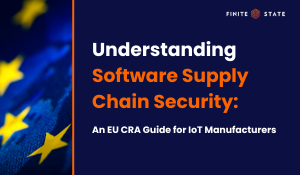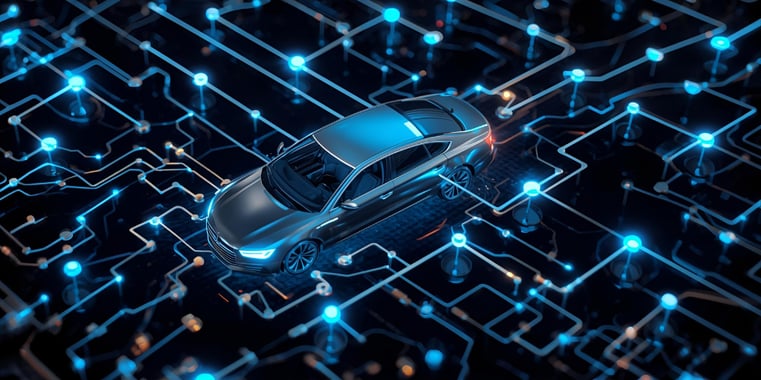Regulators are drawing a line in the sand: connected vehicles sold in the U.S. must no longer include components or software that could compromise national security. The U.S. Department of Commerce’s Connected Vehicle Rule (CVR), originally proposed in 2024, represents a significant shift in how automotive OEMs, Tier 1s, and technology suppliers must approach supply chain transparency and cyber risk management.
This isn’t just about ticking compliance boxes. The CVR is a response to increasing concerns that software and hardware tied to foreign adversaries, specifically the People’s Republic of China (PRC) and Russia, could be used to exfiltrate data, introduce vulnerabilities, or exert control over connected vehicle systems.
With the rule’s software prohibitions taking effect on model year 2027 cars (generally set for release in mid-2026), OEMs have only a few months to ensure that their vehicles are compliant.
What Is the Connected Vehicle Rule Trying to Solve?
The modern vehicle is effectively a mobile data center. With 5G connectivity, over-the-air (OTA) updates, telematics, and autonomous driving systems, vehicles now generate and transmit enormous volumes of data, much of it sensitive, proprietary, or safety-critical.
The CVR aims to prevent this data and control over vehicle systems from falling into the hands of foreign entities that could exploit it. Specifically, the rule would ban U.S. companies from using components (hardware, software, or services) in connected vehicles if the companies that design, develop, manufacture, or supply those components are owned, controlled by, or otherwise tied to China or Russia.
At a time when global automotive supply chains span dozens of countries and hundreds of vendors, this will introduce a massive operational challenges for most OEMs and suppliers.
Who Will Be Affected? More Companies Than You Think.
While the initial headlines focus on automakers, the true reach of the rule is broader. It applies to:
- OEMs that import or manufacture connected vehicles for sale in the U.S.
- Tiered suppliers providing everything from ECUs and telematics modules to embedded software libraries
- Aftermarket connectivity vendors whose technology is integrated into covered vehicles post-sale
What Technologies Fall Under Scrutiny?
The CVR zeroes in on any component that directly enables or supports vehicle connectivity. This includes:
- Telematics control units and their software stacks
- Onboard diagnostic interfaces with remote data transmission
- Over-the-air (OTA) update systems
- Autonomous driving algorithms
- Data collection and analytics platforms, especially those using cloud services
- Software used in ECUs and communication modules
Even low-level software or middleware components—like bootloaders, drivers, or protocol stacks—could fall within scope if they facilitate data access or remote control functions.
The complication? Many of these components are supplied via multi-tiered chains, with opaque licensing and outsourced development, making it difficult to assess origin or ownership without intensive SBOM and supplier diligence.
The Risk of Non-Compliance: Exclusion from the U.S. Market
Non-compliant vehicles may be blocked from import or sale in the United States, and that risk extends upstream. If a Tier 2 supplier is using software licensed from a PRC-controlled entity, and that software flows into a covered component delivered to a Tier 1, which then goes into a production vehicle, the entire chain is prohibited under the CVR.
This is why the rule doesn’t merely encourage due diligence. It demands it.
Legacy Software and the Compliance Timeline
The Department of Commerce recognizes that adjusting supply chains to the requirements of the CVR may take time. To that end, the CVR includes a “legacy carve-out” for software developed by a covered entity prior to March 17, 2026, provided that the software is not “maintained, augmented, or otherwise altered” by a covered entity following the cutoff date.
While this presents some helpful flexibility to OEMs and suppliers, this means that no covered entity can contribute a software updates or even a single line of code to the covered software.
What Will Compliance Actually Require?
At a minimum, manufacturers and suppliers will need to maintain a full inventory of hardware and software components used in any product connected to a CVR-regulated system. This includes:
- Software Bills of Materials (SBOMs) for all embedded code, libraries, and dependencies, first-party and third-party
- Hardware Bills of Materials (HBOMs) identifying suppliers and country of origin for critical components
- Supplier relationship documentation, including ownership lineage and licensing agreements
- Proof of mitigation or substitution for at-risk components
All of this must be available for review by regulators, and may be subject to audit, especially for suppliers claiming carve-out status or pursuing authorizations.
The Road Ahead: What You Should Do Now
The lead time required to map your supply chain, generate SBOMs, assess third-party risk, and identify problematic components can be measured in months, not weeks.
To prepare effectively:
- Conduct a full inventory of connected vehicle platforms and dependencies.
- Begin generating SBOMs and HBOMs, ideally using automated tools, like Finite State, that integrate into your CI/CD pipelines.
- Engage with your suppliers to uncover component origin, licensing, and ownership structures.
- Assess whether covered software can qualify under the legacy carve-out, which would require immediate planning for the migration of intellectual property rights and software development/update functions.
- Identify legal and cybersecurity partners who can assist with documentation, due diligence, and risk mitigation.
Conclusion: Compliance Starts Now
The Connected Vehicle Rule represents a new era of supply chain accountability in the automotive sector. For companies that embrace it early, this is an opportunity to modernize software practices, eliminate hidden risks, and future-proof access to key markets.
But for those who wait? The cost may be non-compliance, market exclusion, and reputational damage.
At Finite State, we’re already helping OEMs and suppliers get ahead of the curve, mapping complex software supply chains, generating validated SBOMs, and enabling proactive compliance with the CVR and other global regulations.
Whether you're building your compliance roadmap or racing to remediate third-party risk, Finite State is here to support you. Talk to our services team for hands-on guidance, or book a demo to see how our platform can streamline compliance and reduce cyber risk across your connected vehicle ecosystem.
Want a Deeper Dive?
Hear directly from experts at Akin, Alliance for Automotive Innovation, and Finite State on how to prepare your organization for compliance, mitigate supplier risk, and future-proof your connected vehicle platforms.
Subscribe to Our Blog
Get the latest posts delivered straight to your inbox weekly.
Share this
You May Also Like
These Related Stories

Unpacking Compliance: What Due Diligence Looks Like Under the Connected Vehicle Rule

Software Supply Chain Security Under the EU Cyber Resilience Act


